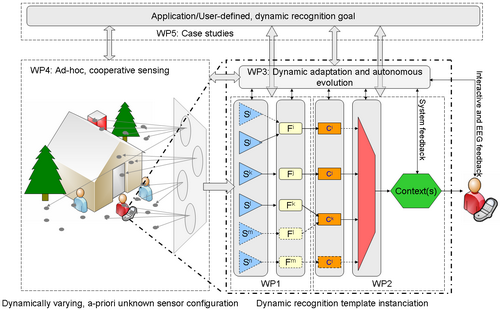Partner login
Approach and Architecture
Approach and architecture
OPPORTUNITY proposes a novel, dynamic, adaptive paradigm to remove the up-to-now static constraints placed on sensor availability, placement and characteristics.

Opportunity Architecture
The approach of OPPORTUNITY to context/activity recognition. It includes ad-hoc cooperative sensing to obtain data about the user and surrounding world; a flexible and parameterizeable opportunistic recognition chain; and runtime supervision and adaptation methods to opportunistically cope with changes.
- Ad-hoc, cooperative sensing: A mobile device opportunistically exploits information from sensors placed in the users outfit, in the environment and other sources of information to recognize contexts/activities. Sensors are opportunistically interconnected and enable large scale data acquisition about the user and the world surrounding him.
- Opportunistic context recognition chain: The opportunistic context recognition chain is adjustable at all levels (signal pre-processing, feature extraction, classification, decision fusion, higher level processing), in contrast to traditional approaches. The number and parameters of sensors, features, or classifiers used can be dynamically adjusted according to the performance goal.
- Adaptation: A key element of the opportunistic approach is dynamic adaptation and autonomous evolution on the basis of self-supervision and system/user feedback. Self-supervision and feedback, with corresponding adaptation strategies, enable to control the parameters of the opportunistic context recognition chain to adapt it to the sensor configuration at hand. This enables rapid dynamic adaptation to spontaneous changes in sensor configurations as well as long term autonomous evolution to gradual changes in sensing environments and users.
- Login to post comments
Contact
Do not hesitate to contact the consortium.
About
We develop opportunistic activity recognition systems: goal-oriented sensor assemblies spontaneously arise and self-organize to achieve a common activity and context recognition. We develop algorithms and architectures underlying context recognition in opportunistic systems.
Latest news
Newsletter
Subscribe to our newsletter for regular project updates.




